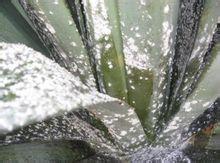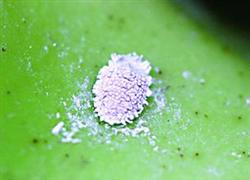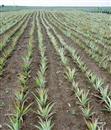Pineapple pink scale

The pineapple pink scale belongs to Homoptera, Coccidae. Pineapple pink scale is the most common. The symptom of damage is that adult and nymph damage pineapple rhizome, leaf, fruit and seedling to suck its juice. The damaged leaves began to show symptoms from the lower part, gradually faded upward and became yellow and finally reddish purple, and in severe cases, all the leaves softened and drooped and withered, resulting in the death of the whole plant; the damaged roots first turned dark brown, then gradually rotted, causing the plant to weaken. After the fruit is damaged, the pericarp has no luster, and the "honeydew" secreted by it can lead to the occurrence of soot disease, serious atrophy, stunted growth and even withering of the seedlings. Morphologically, the adult female adult is about 2.5-3 mm long, oblate-oval, with white wax powder, prominent edges, 7-8 antennae, 17 pairs of prickle groups, secreting waxy hairs, and the gluteal flap has 2 medium-sized conical spines. The tubular glands are distributed in 8 segments of the abdomen, and their edges are distributed in groups. The hindfoot tibial segment is twice as long as the tarsal segment, and the body color of the female is mostly peach. There is a white waxy cotton oocyst at the end of the abdomen at sexual maturity. The male adult is tiny, yellowish brown, with transparent wings, flat on the back and a pair of slender waxes at the ventral end. Has a pair of transparent front wings. The egg body is 0.35ml 0.38mm long, oval, yellow at first, then yellowish brown, irregular woolly, attached to the host plant. The nymph is 3 years old. It is similar to a female adult and has small bodies with antennae and feet. The female nymph becomes an adult after 3 times of molting, and the male nymph turns into pupa after 2 times of molting. The pupa is located in the cocoon sac formed by filamentous wax, the cocoon shape is irregular, mostly long, attached to the plant. The occurrence pattern of one generation takes 45 seconds and 59 days. Only after the female adult absorbs the juice of the host plant can the ovary mature and reproduce, belonging to parthenogenesis, which is mainly viviparous. In winter, especially in January-February, oviposition often occurs, or the interaction between egg and viviparity occurs. Viviparous nymphs have the habit of clustering under the mother, and begin to suck after finding a suitable site, and some of them are motionless near the mother or crawl repeatedly on the mother. The nymph period is generally 30 days in summer and 2 months in winter. The female adult lays eggs in a fluffy oocyst. After Eclosion, male adults generally remain motionless in plant crevices, do not feed, and have a short life span of only a few days. The male nymph stage is about 14 days in summer, and the pupal stage is generally 12: 15 days. Torrential rain or continuous rainfall has a scouring effect on pink scale. Ants carry the insect body of pink scale, which is helpful to the spread of pink scale. Ant dung likes to eat the feces of pink scale, when these excretions are eaten up, it is beneficial to the growth and reproduction of pink scale. Prevention and control methods (1) strengthen orchard management, enhance tree potential, rational fertilization and irrigation, and improve tree resistance. Prune scientifically, cut off diseased and residual branches, adjust ventilation and light transmission. Combined with pruning, cleaning the orchard and reducing the source of insects. (2) choose insect-free seedlings when planting, and soak the head with 40% dimethoate 500 murine 800 times solution if necessary. (3) fumigation and insecticidal seedlings can be fumigated. In an airtight space, the mixture of 10-16g sodium cyanide, 15-24ml sulfuric acid and 40ml water is fumigated for 1-2 hours to get rid of insects, and then it can be planted. (3) turpentine resin, a common agent commonly used in spraying turpentine mixture, occurred seriously in chemical control.
- Prev

Control of pineapple pink scale
The scientific name Dysmicoccusbrevipes (Cockerell) of pineapple pink scale belongs to Homoptera, Coccidae. Pineapple pink scale is the most common. The symptom of damage is that adult and nymph damage pineapple rhizome, leaf, fruit and seedling to suck its juice. The damaged leaves begin to show symptoms from the lower part, gradually fade upward and turn yellow at last.
- Next

Experience of off-season and high-yield cultivation of pineapple
Pineapple cultivation has two rows, three rows and four rows. Double-row type, commonly used borders and grooves with a total of 150cm width, double-row single-plant arrangement. Its advantages are: the furrow is wider, the fibrous root can expand outward, the plant spacing on the border is more uniform, the stem base is squeezed against each other, the leaf extends into a hemispherical surface, it can make full use of sunlight, and it is easy to form between rows.
Related
- Moge, come on! The staff of the peasant association in the producing area of cantaloupe were frightened when the crowd gathered.
- Causes and Solutions of low Fruit setting rate of Apple
- Symptoms and control measures of passion fruit virus disease
- Fruit growing lesson: how do apple orchards keep high yields?
- Can you build orchards in the mountains? What are the pros and cons?
- How to manage the coloring period of Crisson grape?
- This paper introduces the processing technology of two kinds of fig products.
- How much is a month for retired teachers in rural areas by 2020?
- How can strawberry planting increase sugar content? We should pay attention to management in many aspects.
- What are the cultivation techniques on how to improve the yield of golden fruit?

